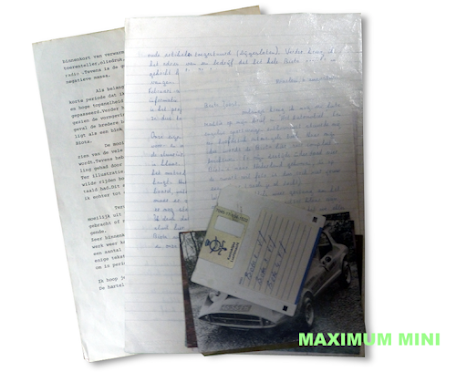When I heard about a Buckle Monaco being superbly restored in Australia recently, I was eager to learn more and got in touch with the car's owner David Wallis. David was kind enough to tell me all about the car's restoration, which won a first place for best restoration recently. Over to him:
"Hi Jeroen, I have put the following together for your blog. The photos show the car as I purchased it, then at the paint and panel shop with the rest being the car as completed. The car is a Mini Monaco, based on a 1962 850 and modified by Bill Buckle Auto Conversions in Sydney, Australia around 1966 / 67. Bill went on to receive the Order of Australia in 2014 for his service to the motor vehicle industry as a designer and retailer. I purchased the car in early 2014 after a chance encounter with a guy at a local Jaguar show. I had driven to the show in my Twini (and he sent me a few pictures of that, too, a real cracker of a car!-JB) and we started chatting about Mini’s in the car park. He commented that a relation of his had an unusual Mini which he thought was a Monaco. This had my attention, and the car was in my possession some three months later. It had been sitting in a shed in a nearby town since 1980."
"I traced the cars history back to a fellow in Queensland who reportedly purchased it from Bill Buckle in 1970. Between 1970 and 1980 there were several owners, a few modifications and some dodgy panel repairs. After purchasing the car I commenced a full nut and bolt restoration, with the aim being to get the car back to the original Monaco condition including a few period performance tweaks. As there were no official records on the Monaco’s produced, the main guide for the rebuild was a range of magazine articles and adds from 1966. First job was to strip the body down ready for grit blasting and etch primer. After this was two years at the paint and panel shop where all rust and dents were removed culminating in a bare metal respray."
"It then took me around four years to put the car back together. This included detailing all components, rebuilding the engine (1275) and gear box with a few performance components including twin SUs, re-upholstering the interior which included the lowered inclined front seats and rebuilding the Cooper 'S' brakes and all suspension. I also hand fabricated a new walnut burl dash facia utilizing the original Broadspeed style upper pad. This incorporated Mk1 Cooper S gauges, along with other classic Smiths instruments. I carried out the majority of the work, with the exception of the paint and panel, purchasing parts from many countries including Australia, France, America, Canada, Portugal, England and Malta. The restoration was completed in October 2020, for its debut showing at Minis at the Mill, an annual show for Minis held at the National Motor Museum in Birdwood, South Australia. The show, organised by The Modified Mini Car Club of SA attracted around 120 cars, were we received 1st place for the best restoration."
That seems totally deserved, thank you for sharing all this David! It is very good to know these cars are being cherished. Another Buckle Monaco, owned by the Lucas family of New South Wales, was restored over a long period of time and won another restoration award two years ago.
Click here for that.
Beautiful Buckle. The car's nut and bolt restoration was completed in October 2020
Picture David Wallis
This is what it looked like in 2014. David: "It had been sitting in a shed since 1980"
Picture David Wallis
The car had seen several owners, a few modifications and some dodgy panel repairs
Picture David Wallis
David stripped it completely, grit blast and etch primered the body before going to the panel shop
Picture David Wallis
Interior was fully re-upholstered with hand made walnut burl dash facia utilizing the
original Broadspeed style upper pad
Picture David Wallis
David: "I carried out the majority of the work, with the exception of the paint and panels"
Picture David Wallis
He rebuilt the 1275 engine and gear box with a few performance components including twin SUs
Picture David Wallis


















































